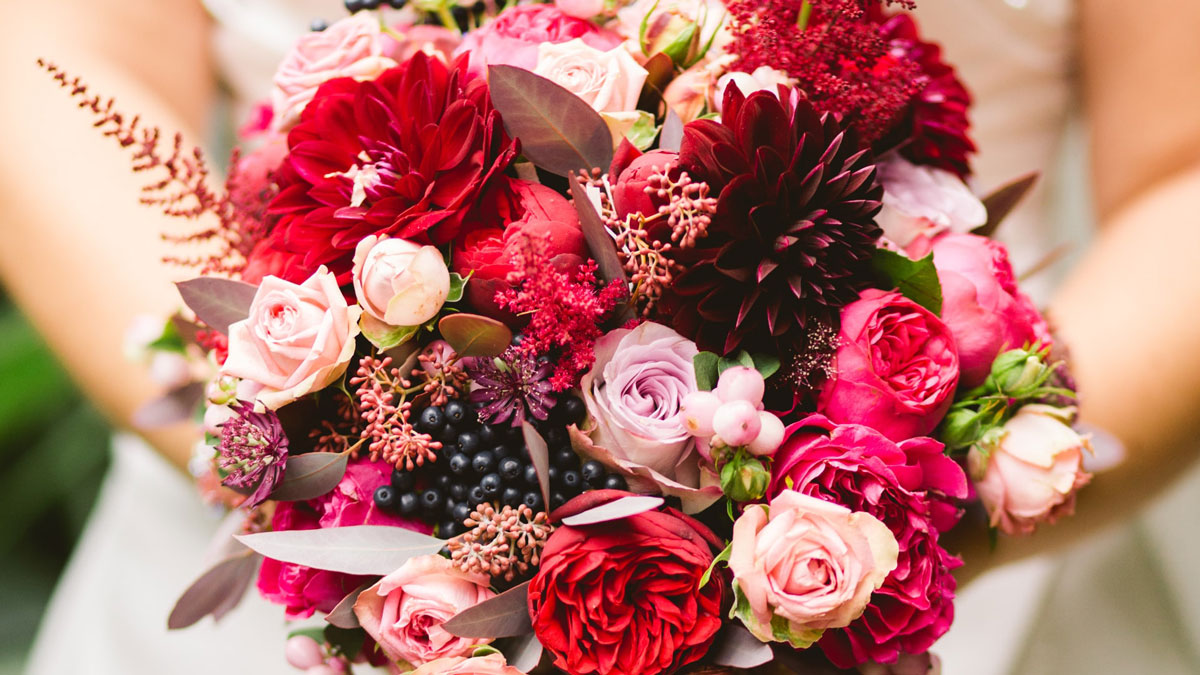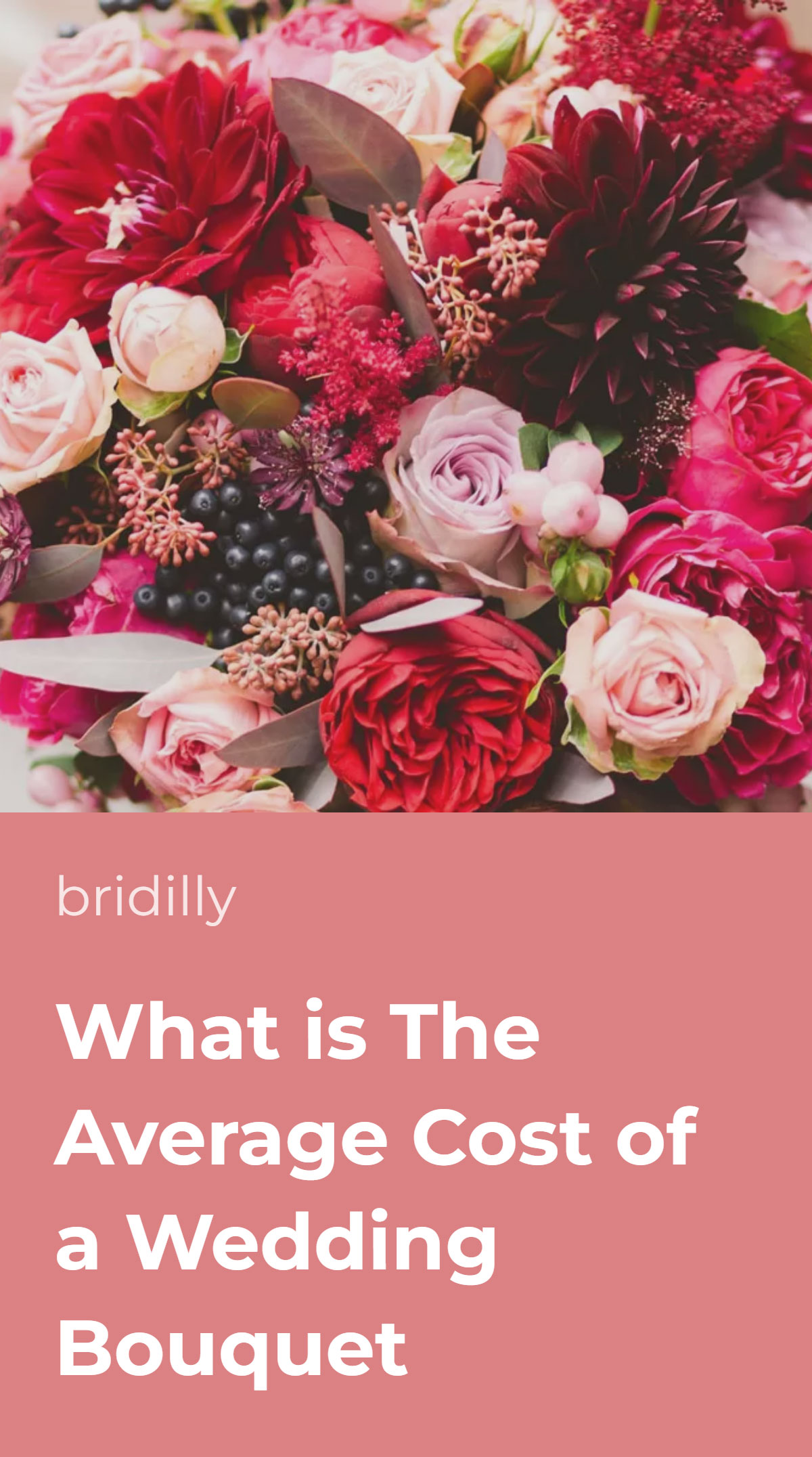At some point in wedding planning, every bride wonders how much does a wedding bouquet cost.
Unfortunately, many brides are in for a surprise because a wedding bouquet is often among the most expensive accessories.
Whether you prefer small, minimalist mono bouquets or sophisticated, large arrangements with exotic blooms, anticipating the potential expenses is vital.
The factors affecting a wedding bouquet cost include flower type, seasonality, arrangement design, labor intensity, and location.
Sometimes, brides have to compromise on their favorite blooms due to high costs. However, a good florist can advise you on how to fit the preferred flowers in your budget.
Table of Contents [show]
Average Cost
On average, flowers account for 5-15% of the total wedding budget. So, if a couple spends $30,000 on a wedding, they can expect to pay about $3,000 on the flowers. Flowers are in the top-five most expensive wedding features.
Altar flowers, centerpieces, and other venue décor comprise most of that sum. Although the wedding bouquet is only a minor part of the floral expenses, it can still be costly. The average price of a bridal bouquet is about $200.
However, the average wedding bouquet price isn’t a good representation of the actual situation. While some brides only pay $40 for their bouquets, others pay over $900.
Type of Flowers
You may wonder – how could some bouquets cost $40 and other $900? After all, the size difference isn’t that big. The bridal bouquet price depends on many factors, with the most influential one being the type of flowers.
Some exotic and rare garden flowers can cost 20 times more than popular cheap wedding flowers. For example, the average cost of phalaenopsis orchid is $28 in wholesale and $98 in retail per stem.
Overall, orchids are leading the list of the most expensive wedding flowers, particularly the cymbidium, oncidium, vanda, and dendrobium varieties. The Rothschild’s orchid can cost $5,000 per stem because the flower price is proportionate to its rarity.
Other pricey wedding flowers are hydrangea and peony, though not nearly as expensive as orchids, coming at about $5.50 in wholesale and $19.25 in retail.
Meanwhile, carnations are the cheapest wedding flowers, coming at $0.50 in wholesale and $1.75 In retail. Other affordable wedding flower varieties include calla lilies, tulips, roses, and anemones, proving that you don’t have to spend a fortune on a gorgeous bouquet.
Sometimes, the same flower class can differ drastically in price depending on the color and variety. For example, the mokara orchid is among the cheapest wedding blooms, priced at $1.50 wholesale and $5 retail.
Roses, one of the most popular wedding flowers, only cost about $0.85 in wholesale for red color and $1 for non-red. Anemones, tulips, and Asiatic lilies are slightly costlier, priced at about $1.25 in wholesale.
Ranunculus, which looks similar to rose, is priced at $4 per stem in retail. Magnolias and dahlias lie in the same price range as ranunculi, but sunflowers, snapdragons, and gladiolus are about twice cheaper.
Prices in wholesale typically cost 3-4 times less than in retail, so it may seem like an excellent way to save money. However, there’s usually a minimum stem number requirement. Buying in bulk may get you an even higher discount.
If you buy in wholesale but only use two stems out of 25 required by the minimum order, the total cost of your bouquet may be even higher than if you buy the flowers in retail.
Because of such a vast difference, most wedding bouquets feature a mix of popular, cheap flowers, filler flowers, greenery, and exotic blooms.
Greenery ranges from $0.50 to $4.50 per stem in retail. Succulents are priced at $5.50 to $15, depending on the size and type. Silk flowers range from $1 to $12 per stem.
Specific flower colors tend to cost more than others, even if the variety is the same – notably red, pink, white, and two-toned blooms.
Bouquet Size
The flower prices stated above are per stem, so the wedding bouquet cost can vary drastically depending on its size – or, more specifically, on the stem number.
For instance, a small bouquet with 8-12 roses may cost you only $26-$40 in retail, but a large arrangement from 25 stems will cost about $85. Note that this price doesn’t include labor costs.
Some seemingly expensive blooms can be cost-effective for a bouquet due to their volume. For example, two-three hydrangea flowers have about the same volume as ten roses and cost about $15 in wholesale or $40 in retail.
There’s no universal rule about how large a bridal bouquet should be. The bouquet size depends on the bride’s style and budget.
A bouquet from mixed flowers (focal, secondary, filler flowers, and greens) typically contains 18-20 stems. About ten stems make a beautiful small bouquet, and a large arrangement requires over 25 stems.
The best way to save on a wedding bouquet is to choose flowers strategically, considering both the price per stem and the volume. An experienced florist can help you fit the desired blooms in your budget.
Season
Season also plays a role in the wedding flower price. Choosing seasonal blooms can help you save a good sum, whereas out-of-season varieties often need to be brought from the other part of the globe and are therefore costly.
U.S. florists typically rely on growers and shippers in South America, Africa, New Zealand, and Holland for out-of-season blooms. And if shipping from South America may not be that expensive, imagine the amount of fuel needed for a flight from South Africa.
For example, a store may sell white peonies at $11 per stem in June, when they’re in season, and $15 per stem from November to May, when they are rare.
Thankfully, some popular flowers bloom year-round. These include roses, baby’s breath, calla lilies, carnations, delphinium, gardenia, and many greens, such as eucalyptus.
Flower prices can also spike during Easter, Valentine’s Day, Mother’s Day, and other holidays. Avoid ordering your bridal bouquet during holiday periods due to increased demand.
If you want to save on your wedding bouquet or care about the environment and don’t want to contribute to pollution, consider gardenias, peonies, agapanthus, hyacinths, narcissus, and lily of the valley for a spring wedding.
Summer seasonal wedding flowers include dahlias, peonies, hydrangeas, gladiolus, cockscomb, lavender, and sunflowers. Fall brides can look into dahlias, chrysanthemums, lilies, crocus, and asters.
Lastly, the selection of winter wedding flowers isn’t as vast but undoubtedly beautiful, featuring hellebores, orchids, snapdragons, poinsettias, pansies, and violas.
Bouquet Intricacy
The bouquet design intricacy may also affect its cost. Crescent and cascading bouquets tend to be large and elaborate; complex shapes require a higher florist skill level.
Despite the small size, pomander bouquets can also cost more than traditional arrangements. This is because even a small pomander bouquet requires at least 24 roses or similarly sized flowers.
Naturally, the more complex is the bouquet construction, the more time the florist will need to spend on making it, and the higher the price will be.
Labor Costs
Apart from the base cost of flowers and greenery, the wedding bouquet price includes the labor costs. Labor refers to every step of the bouquet creation, from designing it to sourcing the freshest blooms and assembling the arrangement.
Additionally, the florist’s labor includes communication with the couple. This point often gets overlooked but answering phone calls, e-mails, and meetings in person takes time, and time is money.
The florist rates largely depend on their expertise. On average, florists in the U.S. charge from $8 to $35 per hour, but top-tier florists can charge over $80 per hour.
A top-rated florist working with celebrities in Manhattan is unnecessary for most couples. However, sparing on the florist also isn’t wise because a real expert can help you pick the best flowers and design and will certainly make a gorgeous, fresh bouquet.
The more intricate a bouquet is, and the more time the florist must spend making it, the higher the price. As a rule of thumb, labor costs comprise about 20% of the bouquet’s retail price.
Then, you may have to pay for the bouquet delivery. The delivery costs are tricky to estimate because they vary depending on the florist and delivery distance.
Furthermore, bridal bouquets aren’t typically delivered alone but along with flowers for venue decoration. If you design your bouquet and pick it up yourself, you may save a good sum.
Your Location
The last but not least factor affecting your wedding bouquet price is the location. Any wedding feature is pricier in major metro areas than in small towns, and flowers aren’t an exception.
The most expensive states overall to get married are Massachusetts, New Jersey, Connecticut, the District of Columbia, and New York. Flowers are one of the contributing factors.
On the other hand, bridal bouquets in Arkansas, West Virginia, Kentucky, and Oklahoma tend to be the cheapest.
Furthermore, specific flower varieties are cheaper in some states because they can be locally grown. California is America’s largest cut flower producer, followed by Florida.















No Comments Add one
Leave a Comment